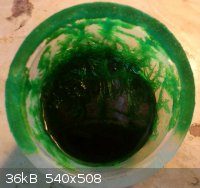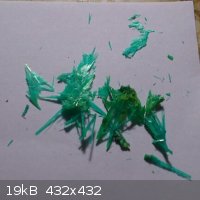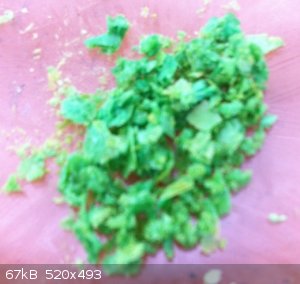| Pages:
1
2 |
Chemistry_Keegan
Harmless

Posts: 45
Registered: 16-2-2013
Location: Nova Scotia
Member Is Offline
Mood: Interested
|
|
Reactions Of Copper With Ferric Chloride
As most of you are probably aware, ferric chloride is often used as an enchant for printed circuit boards. I was particularly interested in the
chemistry of this reaction, so I did a little research and found this. One of the reasons I researched this was because I knew it couldn't have been a plain single displacement reaction, because copper is less
reactive than iron. So, as Woelen explained in that forum, the ferric ions actually oxidize the copper to form the tetrachlorocuprate coordination
complex, which in turn oxidizes even more copper to form the dichlorocuprate complex after all the ferric ions have been transformed into ferrous
ions. He also mentioned the chloride concentration needs to be really high for these reactions to proceed, which can easily be accomplished with
sodium chloride.
My question is, once the solution has absorbed as much copper as it can, what would form upon evaporating all the water away? Would the coordination
complexes stay as they are, and form ferric dichlorocuprate, or sodium dichlorocuprate if sodium chloride was used? Or would they both decompose into
ferric chloride, sodium chloride, and cuprous chloride? Also, if the coordination complexes do indeed remain unchanged, could they still be used as a
route to cuprous chloride? Sorry if these questions have obvious answers, I'm just beginning to learn about coordination complexes 
[Edited on 1-4-2014 by Chemistry_Keegan]
|
|
|
blogfast25
International Hazard
    
Posts: 10562
Registered: 3-2-2008
Location: Neverland
Member Is Offline
Mood: No Mood
|
|
Evaporating anything 'cuprous' means exposing it to air and air oxygen oxidises cuprous salts very quickly. Even kept under water, CuCl is very prone
to oxidising to Cu (II).
I'm not sure salts of the complex CuCl<sub>4</sub><sup>2-</sup> actually exist as solids. In the spent etching solution there
are no cations other than Cu2+, Fe2+ and maybe Cu+.
I think CuCl<sub>4</sub><sup>2-</sup> on evaporation will manifest itself as:
Cu<sup>2+</sup> + CuCl<sub>4</sub><sup>2-</sup> === > 2 CuCl<sub>2</sub> (otherwise one would have
to consider Cu (II) chloride as [Cu<sup>2+</sup>][CuCl<sub>4</sub><sup>2-</sup>], "copper (II) tetrachloro
cuprate")
Similarly with the Fe (II) complex...
The stability constants of these two chloro complexes are quite low, if I recall well.
[Edited on 1-4-2014 by blogfast25]
|
|
|
aga
Forum Drunkard
    
Posts: 7030
Registered: 25-3-2014
Member Is Offline
|
|
Interesting, as i generally use Ferric Chloride to etch pcbs.
I knew that adding a little sulphuric acid speeds up the process (as does a reasonable temperature ~40 C) but adding salt ?
I'll try it and see if it does anything nasty to the photo-resist material.
|
|
|
Chemistry_Keegan
Harmless

Posts: 45
Registered: 16-2-2013
Location: Nova Scotia
Member Is Offline
Mood: Interested
|
|
Quote: Originally posted by blogfast25  | | Evaporating anything 'cuprous' means exposing it to air and air oxygen oxidises cuprous salts very quickly. Even kept under water, CuCl is very prone
to oxidising to Cu (II). |
Oops, when I asked if this could be used as a route to cuprous chloride, I really meant to say cupric chloride, so if I understood correctly, this
actually works out well for me. I am trying to make the cupric chloride for other experiments, and since the chemicals available to me are very
limited at the moment, this appears to be the only plausible way for me to do so.
Correct me if I'm wrong, but this is my understanding of what I can do so far:
FeCl3 (s) + NaCl (s) → Na+ (aq) + FeCl4- (aq)
2 FeCl4- (aq) + Cu (s) → CuCl42- (aq) + 2 Fe2+
(aq) + 4 Cl- (aq)
2 Na+ (aq) + CuCl42- (aq) + 2 Fe2+ (aq) + 4 Cl-
(aq) → 2 FeCl2 (s) + 2 NaCl (s) + CuCl2 (s)
For an overall reaction of:
2 FeCl3 (s) + 2 NaCl (s) + Cu (s) → 2 FeCl2 (s) + 2 NaCl (s) +
CuCl2 (s)
I omitted this reaction:
CuCl42- (aq) + Cu (s) → 2 CuCl2- (aq)
Because, as you said, the oxygen just oxidizes the copper back to it's oxidation state of plus two. But I feel I misunderstood something. Does the
oxygen simply aid in reversing the above reaction, like this:
2 CuCl2- (aq) → CuCl42- (aq) + Cu (s)
Or does it actually participate in yet another reaction?
Anyway, if the first four equations are indeed accurate, is their an easy way to go about separating the tree chloride salts? Thank you for all the
info that you already provided! I apologize if I'm getting ahead of myself by asking too many questions at once 
[Edited on 1-4-2014 by Chemistry_Keegan]
|
|
|
Chemistry_Keegan
Harmless

Posts: 45
Registered: 16-2-2013
Location: Nova Scotia
Member Is Offline
Mood: Interested
|
|
Quote: Originally posted by aga  |
Interesting, as i generally use Ferric Chloride to etch pcbs.
I knew that adding a little sulphuric acid speeds up the process (as does a reasonable temperature ~40 C) but adding salt ?
I'll try it and see if it does anything nasty to the photo-resist material. |
This should normally just be the case for homemade ferric chloride. If you bought some specifically for that purpose, chances are the chloride
concentration is already high enough for the reactions to proceed properly. However, it should never hurt to add some extra chloride if the solution
isn't already saturated.
[Edited on 1-4-2014 by Chemistry_Keegan]
|
|
|
blogfast25
International Hazard
    
Posts: 10562
Registered: 3-2-2008
Location: Neverland
Member Is Offline
Mood: No Mood
|
|
Quote: Originally posted by Chemistry_Keegan  | Or does it actually participate in yet another reaction?
Anyway, if the first four equations are indeed accurate, is their an easy way to go about separating the tree chloride salts? Thank you for all the
info that you already provided! I apologize if I'm getting ahead of myself by asking too many questions at once 
|
It is an actual oxidation: the oxygen actually absorbs the electron from:
Cu<sup>+</sup> === > Cu<sup>2+</sup> + e
1/2 O<sub>2</sub> + 2 H<sup>+</sup> + 2 e === > H<sub>2</sub>O
Separating the Cu(II) and Fe(II) chlorides may prove difficult. For one, the Fe(II) is oxidised back to Fe(III) fairly easily due to the second
reaction (above).
I don't see it as a practical route to CuCl2. Much easier is to precipitate a known quantity of Cu(OH)2 and dissolve it in minimum needed amount of
HCl.
Incidentally, I think your 'how to' link is wrong about generating Cu<sup>+</sup>: the etching solution would have become far too weak to
still be useful, well before Cu(II) + Cu(0) === > Cu(I) would kick in. But prolonged exposure of a spent etching solution to copper would probably
start that reaction.
[Edited on 2-4-2014 by blogfast25]
|
|
|
Chemistry_Keegan
Harmless

Posts: 45
Registered: 16-2-2013
Location: Nova Scotia
Member Is Offline
Mood: Interested
|
|
Quote: Originally posted by blogfast25  | It is an actual oxidation: the oxygen actually absorbs the electron from:
Cu<sup>+</sup> === > Cu<sup>2+</sup> + e
1/2 O<sub>2</sub> + 2 H<sup>+</sup> + 2 e === > H<sub>2</sub>O |
But where do the positive hydrogen ions come from?
|
|
|
blogfast25
International Hazard
    
Posts: 10562
Registered: 3-2-2008
Location: Neverland
Member Is Offline
Mood: No Mood
|
|
Auto-dissociation of water:
2 H2O < === > H3O+ + OH-
In the case where ferric ions are present, hydrolysis of these:
[Fe(H2O<sub>6</sub>]<sup>3+</sup> + H2O < === > [Fe(H2O<sub>5</sub>(OH)]<sup>2+</sup> +
H3O<sup>+</sup>
Further deprotonation of the ferric aqua ion leads to ferric hydroxide precipitation.
The oxidation of Cu(I) to Cu(II) also takes place in neutral/alkaline conditions (as does the oxidation of Fe(II) to Fe(III)):
1/2 O2 + H2O + 2 e === > 2 OH-
[Edited on 2-4-2014 by blogfast25]
|
|
|
Chemistry_Keegan
Harmless

Posts: 45
Registered: 16-2-2013
Location: Nova Scotia
Member Is Offline
Mood: Interested
|
|
Sorry to bother you again, but what you're saying just isn't making sense to me. I can't seem to find a way for the oxidation of cuprous chloride to
work with the reactions you described. You mentioned that it would oxidize in the presence of air, but then you implied water is required for it to
happen, via its dissociation. Also, the equations you provided don't even seem to work with water anyway, due to fact that the charges and quantities
of all the ions and chemicals can't balance.
I just don't understand how cuprous chloride can be oxidized to cupric chloride, without extra hydrochloric acid involved, like in this reaction:
4 CuCl + O2 + 4 HCl → 4 CuCl2 + 2 H2O
Otherwise this just seems impossible. I hear many people refer to other salts being oxidized by air, but it seems as though they must always be in
solution with an excess amount of their related acid in order for this to actually occur.
|
|
|
DraconicAcid
International Hazard
    
Posts: 4278
Registered: 1-2-2013
Location: The tiniest college campus ever....
Member Is Offline
Mood: Semi-victorious.
|
|
If there's no acid, then 2 H2O + 4 CuCl + O2 --> 2 Cu(OH)2 + 2 CuCl2
Please remember: "Filtrate" is not a verb.
Write up your lab reports the way your instructor wants them, not the way your ex-instructor wants them.
|
|
|
Chemistry_Keegan
Harmless

Posts: 45
Registered: 16-2-2013
Location: Nova Scotia
Member Is Offline
Mood: Interested
|
|
Just as I thought, I misunderstood what Blogfast was trying to say. When he said that the copper would be oxidized again, I made the assumption that
it would simply be reverted back to cupric chloride, without considering the fact that the copper could also form a salt with the hydroxide anion.
Silly me  A big thanks to both of you for putting up with my temporary
obliviousness A big thanks to both of you for putting up with my temporary
obliviousness 
[Edited on 3-4-2014 by Chemistry_Keegan]
|
|
|
eidolonicaurum
Hazard to Self
 
Posts: 71
Registered: 2-1-2014
Location: Area 51
Member Is Offline
Mood: Hydric
|
|
A while back I dissolved some copper up in concentrated hydrochloric acid (with a very little sodium chlorate to help oxidise the copper and dissolve
it. This may be total rubbish) and evaporated the solution. I obtained a dark green solid. Cupric chloride is blue, the tetrachlorocuprate(II) ion is
dark green. So why, if this complex is unstable in solid form, does the solid resemble it? On dilution in water, a white precipitate forms, with a
blue solution.
|
|
|
blogfast25
International Hazard
    
Posts: 10562
Registered: 3-2-2008
Location: Neverland
Member Is Offline
Mood: No Mood
|
|
For starters, are you sure your product corresponded to the stoichiometry of CuCl<sub>2</sub>? You had excess HCl in there and
KClO<sub>3</sub> which yields KCl. Now you boil all that down, but what have you got?
That proper CuCl<sub>2</sub> is blue kind of proves that Cu II tetrachlorocuprate doesn't exist as a solid, or it would be green.
[Edited on 9-4-2014 by blogfast25]
|
|
|
aga
Forum Drunkard
    
Posts: 7030
Registered: 25-3-2014
Member Is Offline
|
|
Note to self : never wear tinted eye-protection, and always use sunlight + the Good eye for basic spectrometry.
|
|
|
eidolonicaurum
Hazard to Self
 
Posts: 71
Registered: 2-1-2014
Location: Area 51
Member Is Offline
Mood: Hydric
|
|
No, but I know that cuprous compounds are almost always colourless (excepting cuprus oxide), so it should be a cupric compound. The colour is the same
as tetrachlorocuprate(II) but it clearly isn't. What do you think it might be?

The crystals are also somewhat hygroscopic...
[Edited on 11-4-2014 by eidolonicaurum]
|
|
|
blogfast25
International Hazard
    
Posts: 10562
Registered: 3-2-2008
Location: Neverland
Member Is Offline
Mood: No Mood
|
|
Odd, that green really is very reminiscent of tetrachlorocuprate. Try drying them: in solution CuCl<sub>2</sub> really is green, because
those pesky tetrachlorocuprate anions then form. My guess is that if you dry your product properly it will end up blue.
Quote: Originally posted by aga  | | Note to self : never wear tinted eye-protection, and always use sunlight + the Good eye for basic spectrometry. |
Totally true: observing colour objectively is hard. Rose tinted specs can be fun but not in science.
[Edited on 11-4-2014 by blogfast25]
|
|
|
eidolonicaurum
Hazard to Self
 
Posts: 71
Registered: 2-1-2014
Location: Area 51
Member Is Offline
Mood: Hydric
|
|
The crusting around the edge is more of the same substance, and there are some crystals in the pot, but I'll separate them out and dry them. The
browny colour is just a reflection of something, I don't know what.
|
|
|
DraconicAcid
International Hazard
    
Posts: 4278
Registered: 1-2-2013
Location: The tiniest college campus ever....
Member Is Offline
Mood: Semi-victorious.
|
|
Hydrated copper(II) chloride is green, possibly greenish-blue. Anhydrous copper(II) chloride is a chocolate brown.
Please remember: "Filtrate" is not a verb.
Write up your lab reports the way your instructor wants them, not the way your ex-instructor wants them.
|
|
|
blogfast25
International Hazard
    
Posts: 10562
Registered: 3-2-2008
Location: Neverland
Member Is Offline
Mood: No Mood
|
|
Hmmm... see for instance the Wiki photo: looks more blue than green to me....
|
|
|
eidolonicaurum
Hazard to Self
 
Posts: 71
Registered: 2-1-2014
Location: Area 51
Member Is Offline
Mood: Hydric
|
|
It looks like the crystals must have had a little liquid adhering to them, or a similar problem has occured that mrhomescientist encountered here

|
|
|
Texium
Administrator
       
Posts: 4508
Registered: 11-1-2014
Location: Salt Lake City
Member Is Offline
Mood: PhD candidate!
|
|
I'm having that same issue with the weird green copper(II) chloride, but I take it from this last picture that yours did dry out properly.
Just for clarification, was it necessary to use a desiccator, or were you able to dry them solely by evaporation? I left mine outside for a few days
and it was still quite green.

It looks darker green in person
[Edited on 6-22-2014 by zts16]
|
|
|
Brain&Force
Hazard to Lanthanides
    
Posts: 1302
Registered: 13-11-2013
Location: UW-Madison
Member Is Offline
Mood: Incommensurately modulated
|
|
Isn't solid copper(II) chloride a neutral complex with copper(II) ions coordinating to two water molecules and two chloride ions?
I would think anhydrous CuCl2 would be copper(II) tetrachlorocuprate.
At the end of the day, simulating atoms doesn't beat working with the real things...
|
|
|
Texium
Administrator
       
Posts: 4508
Registered: 11-1-2014
Location: Salt Lake City
Member Is Offline
Mood: PhD candidate!
|
|
I don't know, I was under the impression that it was a normal ionic compound, usually seen as the blue-green (much more blue than what I have)
dihydrate, and that it only forms complexes when there are excess chloride ions in solution.
|
|
|
Texium
Administrator
       
Posts: 4508
Registered: 11-1-2014
Location: Salt Lake City
Member Is Offline
Mood: PhD candidate!
|
|
I left it in my desiccator for a few hours, and it's all brown now, as is to be expected with anhydrous copper(II) chloride. I think I will add a
stoichiometric amount of water to make it into the dihydrate without letting it get overly saturated and see if it assumes the proper color.
|
|
|
Brain&Force
Hazard to Lanthanides
    
Posts: 1302
Registered: 13-11-2013
Location: UW-Madison
Member Is Offline
Mood: Incommensurately modulated
|
|
Maybe there's a slight excess of chloride from some other source, like sodium chloride, that's turning the product green. But the light color, that's
what gets me. The copper chloride source I've been using for the past few months is really dark.
At the end of the day, simulating atoms doesn't beat working with the real things...
|
|
|
| Pages:
1
2 |